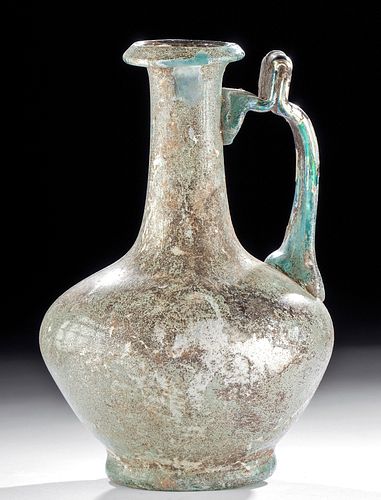Superb Eastern Roman Glass Jug - Great Iridescence
Lot 46b
About Seller
Artemis Gallery
686 S Taylor Ave, Ste 106
Louisville, CO 80027
United States
Selling antiquities, ancient and ethnographic art online since 1993, Artemis Gallery specializes in Classical Antiquities (Egyptian, Greek, Roman, Near Eastern), Asian, Pre-Columbian, African / Tribal / Oceanographic art. Our extensive inventory includes pottery, stone, metal, wood, glass and textil...Read more
Categories
Estimate:
$1,500 - $2,000
Absentee vs Live bid
Two ways to bid:
- Leave a max absentee bid and the platform will bid on your behalf up to your maximum bid during the live auction.
- Bid live during the auction and your bids will be submitted real-time to the auctioneer.
Bid Increments
| Price | Bid Increment |
|---|---|
| $0 | $25 |
| $300 | $50 |
| $1,000 | $100 |
| $2,000 | $250 |
| $5,000 | $500 |
| $10,000 | $1,000 |
| $20,000 | $2,500 |
| $50,000 | $5,000 |
| $100,000 | $10,000 |
| $200,000 | $20,000 |
About Auction
By Artemis Gallery
Feb 13, 2020
Set Reminder
2020-02-13 10:00:00
2020-02-13 10:00:00
America/New_York
Bidsquare
Bidsquare : Exceptional Antiquities, Asian, Ethnographic
https://www.bidsquare.com/auctions/artemis-gallery/exceptional-antiquities-asian-ethnographic-4848
An important one-day auction featuring museum-worthy examples of Egyptian, Greek, Roman, Etruscan, Near Eastern, Far East / Asian, Pre-Columbian, African / Tribal, Oceanic, Native American, Spanish Colonial, Russian, Fossils, Ancient Jewelry, Fine Art, so much more! Artemis Gallery info@artemisgallery.com
An important one-day auction featuring museum-worthy examples of Egyptian, Greek, Roman, Etruscan, Near Eastern, Far East / Asian, Pre-Columbian, African / Tribal, Oceanic, Native American, Spanish Colonial, Russian, Fossils, Ancient Jewelry, Fine Art, so much more! Artemis Gallery info@artemisgallery.com
- Lot Description
Roman, Eastern Empire, Holy Land, early Imperial Period, ca. 1st to early 2nd century CE. An outstanding example of a utilitarian jug, free-blown from translucent glass of a soft blue-green hue. The vessel presents with a protruding foot surrounding a smooth pontil scar, a lightly compressed, apple-shaped body with a sloped shoulder, a tapered cylindrical neck topped with a flared rim bearing an in-folded lip, and an applied trail handle with a pinched thumb rest on top. Vessels of this size were used for storing table oils or garum (fermented fish sauce) in the dining room as well as containing thicker perfumed oils that would not evaporate as quickly. Brilliant layers of silvery and rainbow-hued iridescence envelop the entire composition and gracefully complement the vessel's turquoise color. Size: 3.875" W x 5.6" H (9.8 cm x 14.2 cm)
For a stylistically similar example of a soft yellow-brown hue, please see The Metropolitan Museum of Art, accession number 74.51.133.
Provenance: private Florida, USA collection; ex-private B. Rhodes collection, Florida, USA, purchased from the Archaeological Center, Tel Aviv, Israel (April 8, 1993, lot 126)
All items legal to buy/sell under U.S. Statute covering cultural patrimony Code 2600, CHAPTER 14, and are guaranteed to be as described or your money back.
A Certificate of Authenticity will accompany all winning bids.
We ship worldwide and handle all shipping in-house for your convenience.
#151614Minor abrasions and encrustations to foot, body, handle, neck, and rim, with light weathering film, minor pitting, and flaking to some areas of iridescence, otherwise intact and excellent. Pontil mark on underside of base. A pontil scar or mark indicates that a vessel was free-blown, while the absence of such a mark suggests that the work was either mold-blown or that the mark was intentionally smoothed away or wore away over time. Nice earthen deposits as well as fabulous silver and rainbow iridescence throughout.Condition
- Shipping Info
-
All shipping is handled in-house for your convenience. Your invoice from Artemis Gallery will include shipping calculation instructions. If in doubt, please inquire BEFORE bidding for estimated shipping costs for individual items.
-
- Buyer's Premium



 EUR
EUR CAD
CAD AUD
AUD GBP
GBP MXN
MXN HKD
HKD CNY
CNY MYR
MYR SEK
SEK SGD
SGD CHF
CHF THB
THB
















